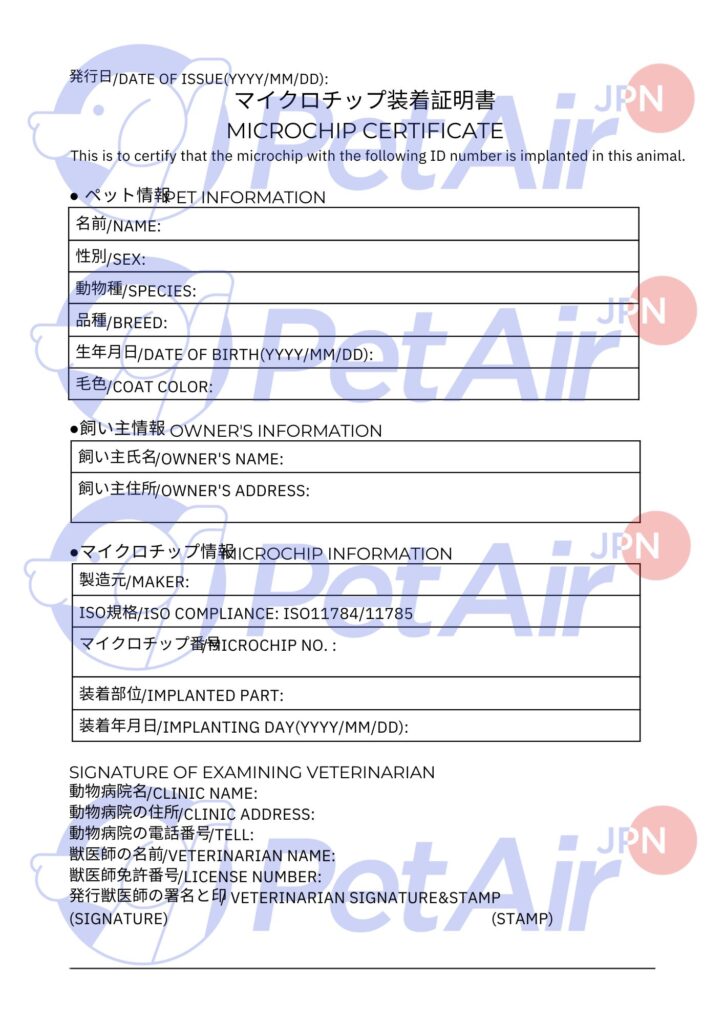Pets Overseas MigrationTo all of you who are planning to Your beloved pets are also important members of your family, and you would like to take them with you when you move abroad.
However, to take your pet abroad, you must have a country-specificAnimal Import RegulationsCareful preparation and procedures are required to clear the In this article, we will explain the technical details as clearly as possible, including a list of preparations and precautions for successful overseas migration with pets, as well as actual common trouble cases and their countermeasures.
Finally.Official LINEPlease feel free to contact us if you have any concerns.
Can I move abroad with my pet? What you need to know first

Conclusion,It is possible to move abroad with your pet.It is. However, unlike moving only humans, each country has strict rules for the international movement of animals.
For example, different countries require different procedures, such as vaccination certificates to prevent rabies and other contagious diseases, designation of quarantine periods, and obtaining import permits. Failure to do so will result in denial of entry, and your pet will be at the airport for an extended period of time.mooring(quarantine) or, in the worst case, deportation orculling(In some cases, the patient may be subject to euthanasia (euthanasia).
To protect your precious family pet, you should first understand the basic rules and the overall process.
The most important thing to remember when taking your pet abroad is to begin preparations well in advance. Depending on the destination, you may have to wait a certain period of time after completing the necessary vaccinations, or it may take several months to complete the procedures. The most important thing to do is to start preparing for your pet's arrival in6 months agoIt is safe to proceed systematically, with the feeling that preparations should start from the beginning of the year.
Preparation Checklist for Pet Overseas Migration

We have compiled a checklist of the main preparation items necessary for emigrating overseas with your pet. Let's check them in order to make sure nothing is left out.
◻︎ Microchip fitting and registration

If your pet has not yet been fitted with an international standard (ISO standard) microchip, we will do so first. Microchips are essential for individual pet identification and are a requirement for entry into many countries.
After installation, registration proceduresDo not forget to also make sure that the registration information (owner's name, contact information, etc.) is correct. Be aware that errors in microchip information can lead to problems with local procedures.
The following article explains microchipping in detail.
◻︎Required vaccinations (rabies, etc.)

Complete any vaccinations required by the destination country. In particularrabies vaccinationis required in almost all countries. In general, proof of rabies vaccination within one year (some countries require proof of vaccination at least 30 days prior to the last vaccination) is required.
In addition, some countries require certificates for distemper, leptospirosis, and parasite control. Check the regulations of the destination country for required vaccinations, and if any are missing, get them at a veterinary clinic as soon as possible.
◻︎ Obtain a physical examination and health certificate from a veterinarian

A health check by a veterinarian is required prior to departure to certify that your pet is healthy enough to travel. In many countries, a health check is required within 7 days prior to departure.Health certificate in English(Health Certificate) is required.
When leaving Japan, this health certificate and vaccine certificate must be used as the basis for the animal quarantine station at the airport.Export Quarantine CertificateYou will need to have the veterinarian issue a The health certificate must be signed and sealed by a veterinarian, so be careful not to omit any procedures.
◻︎Applications related to imports and exports (notifications to quarantine stations and authorities)
Application procedures are to be made to the respective authorities of the source and destination countries. When leaving Japan, an advance application for export inspection must be made to the animal quarantine station with jurisdiction over the departure airport (it is recommended to contact the quarantine station at least 7 days prior to departure).
In addition, depending on the destination countryAnimal Import Permitor advance application may be required. For example, in Australia, New Zealand, and Singapore, it is necessary to apply for and obtain permission from the authorities before departure. It is advisable to complete the various applications well in advance.
◻︎ airline reservations and pet transportation arrangements
Select a flight that allows pets and make a reservation with the airline to check in your pet. Each airline has a limit on the number and size of pets that can accompany you in the cabin, and there is a cap on the number of pets that can be accepted.Secure a pet slot at the same time you book your airline ticket.Do the following.
In addition, check the flow of events on the day of travel (check-in procedures and how to present necessary documents). If it is difficult to make arrangements on your own, consider hiring a professional pet transportation service.
◻︎Preparing and breaking in a travel crate (cage)
Sturdy and safe for long journeysCrate for air transportwill be provided. The crate must be of a size and construction that meets International Air Transport Association (IATA) standards.
Once purchased, it is important to familiarize your pet with the crate before you leave. Let them practice spending time in the crate on a regular basis, and make it a relaxing space with a secure blanket and scented toys. If they are not accustomed to the crate, they may panic and injure themselves during transportation, so please plan ahead to acclimate them to the crate.
◻︎Preparation of new home and local environment
For your pet's comfort in the new location,Pet friendly housingto ensure that the property is safe and secure. If you are renting a property, check whether pets are allowed before signing a contract, and if so, check the conditions such as pet deposit if necessary.
Some destinations require registration of pets (e.g., dog license registration and rabies tag acquisition) upon arrival, so it is a good idea to find out information on these procedures in advance. It is also a good idea to research what kind of veterinary clinics and pet stores are located near your destination, and pick one that you can go to in case of an emergency.
These are the main checklists. At first glance, it may seem like a lot to do, but if you prepare one step at a time, you can be sure to get the job done.
Check the different import requirements for pets in different countries.

Import/export conditions for pets vary widely from country to country. Before traveling, be sure toDestination Updateto make sure that all the necessary conditions are met. For example, in the United Kingdom, an import permit is not required, but proof of rabies vaccination must be presented, and in Australia, a strict quarantine system is in place, requiring a certain period of detention (quarantine isolation).
In Hong Kong, Singapore, and other countries, a government-issued import permit must be obtained before leaving the country. Thus,Which country do you go to?"The procedures and documents required are completely different depending on the
Specific conditions common to many countries are,rabies vaccination certificateand issued by government agencies.Quarantine Certificate (Health Certificate)It is. In addition, some cases of immigration to rabies-free countries (countries with no previous rabies outbreaks) require antibody titer testing several months in advance and a waiting period.
For example, when traveling from Japan to Hawaii or New Zealand, a "waiting period" of 180 days is required after a serum test is conducted in advance and sufficient antibody titers are confirmed. Failure to follow this procedure will result in long-term detention (up to 180 days) upon entry into Japan.
One tip for gathering information is to visit the destination'sEmbassy and government websitesWe recommend that you check the In many cases, the Ministry of Agriculture and quarantine offices of each country publish the import conditions for pets.
If you have difficulty gathering information in English, contact your pet transport agent, who will be able to tell you the latest requirements. Regulations are sometimes updated, so please be sure to obtain the latest official information, and do not judge yourself by saying, "It was OK last year.
Pet Transportation and Safety Measures

The main means of transportation for pets when moving abroad.airplaneIn most cases, the use of a There are two ways to transport pets on airplanes: by carrying them in the cabin with you (carry-on) or by transporting them as checked baggage or cargo. Each has its own advantages and disadvantages, so choose the method best suited to your pet's size, health, and personality.
Accompanied in the cabin (carry-on)
Small dogs and cats may be allowed in the cabin by placing them in a carry-on bag within the airline's regulation size. The advantage is that the pet can stay close to its owner, which reduces stress and allows the owner to check on the pet directly during the trip.
However, this service is not available for pets that exceed the weight or carry-on size limit (e.g., pets weighing 5 to 8 kg or less). Also, the number of pets allowed in the cabin per flight is limited, so early reservations are required.
Transportation in cargo hold (baggage handling/air cargo)
Medium to large size pets that cannot be accommodated in a guest room will be placed here. Pets are transported in a dedicated space with controlled air conditioning and air pressure, but the disadvantages are the anxiety of being separated from their owners and the stress of being in an invisible environment. This is especially true when using the cargo hold.Sturdy and appropriately sized crateand make sure the door is securely locked.
Some airlines may prohibit short-headed breeds (e.g., snub-nosed breeds) from boarding during the summer months or restrict the acceptance of pets in extreme temperatures. than on connecting flights.direct (nonstop) flightIt is also important to reduce the burden on pets by choosing the right time of day, and taking into account the season and time of day to travel at a cooler time.
As a safety measure during transportation,Do not use sedatives on pets easily.It is also important to note that You may feel sorry for them because of the stress of the move, but sedatives have been noted to have risks of side effects such as respiratory depression at high altitudes.
Basically, move the pet in a natural state and support it with preparations that the owner can make (e.g., acclimating it to its crate, tiring it out with sufficient exercise, and utilizing products that have a relaxing effect such as Feliway). On the day of departure, pets should be given a light meal and fluids, and their elimination should be completed before check-in.
New life in the area: what to do after arrival

Once you have successfully completed your trip, it is time to start your life in the new place. Upon arrival, there are a few important steps to take to help your pet adjust to its new environment.
Quarantine procedures upon entry into Japan
At the arrival airport, your pet's documents will be checked and inspected at the animal quarantine station and customs. If there are no deficiencies in the documents submitted here, your pet will be allowed to enter the country and you can return home with your pet.
The quarantine officer will read your pet's microchip and confirm that it matches the information you have provided in your pre-application. In the unlikely event that documentation is missing or conditions are not met, the pet may be quarantined on the spot for a certain period of time (advance preparation is important to avoid this risk).
Pet Registration and Various Procedures
In some countries and regions, pets must be registered and notified within a certain period of time after arrival. For example, in many U.S. states and European countries, dog license registration and proof of rabies vaccination are mandatory.
Follow the instructions of the local city hall and related agencies to complete the necessary registration. The information you have researched in advance will be useful.
Acclimate yourself to the local living environment
Like humans, pets are stressed by changes in their environment. Immediately after moving, rather than cleaning out your belongings, first create a safe space for your pet (a place to rest with its usual bed, blankets, and toys).
Time differences and climate differences may cause them to become ill, so monitor their condition carefully. It is also important to locate a park or dog run on your walking route and maintain a daily exercise routine.
Find a veterinary clinic you can trust.
Find a local veterinarian as early as possible in case you need one. It is also a good idea to visit the veterinary clinics you have researched prior to your trip, or to ask neighborhood pet owners about their reputations.
Since medical treatment costs are often high abroad, consider whether international pet insurance plans or pet options for overseas travel insurance are available.
Know the local rules and etiquette.
Different countries have different manners and ordinances regarding pets. For example, in some places it is required by law to wear a leash, and in some countries it is prohibited to keep certain breeds of dogs.
Also, pet supplies and services that are commonplace in Japan may not be found overseas. Learn about local rules and useful information by joining local pet communities and gathering information on social networking sites and blogs.
Trouble Cases and Countermeasures for Pet Overseas Migration

Even with careful preparation, unexpected problems can occur. Here we introduce some examples of actual problems that tend to occur and their countermeasures. To avoid repeating the same mistakes, take measures in advance.
Entry problems due to incomplete documentation
Postponement of departure due to delay in starting preparations
Non-conforming crates (transport cages)
Pet health problems during flight
In order to prevent the above-mentioned problems from occurring, "preparation with plenty of time to spare" and "advance confirmation" are of the utmost importance. By identifying possible risks and taking countermeasures, you will be able to calmly deal with them when the time comes.
Advantages of consulting with a specialist (free consultation available on official line)
Moving abroad with pets is by no means an easy procedure. In addition to the differences in regulations between countries, managing deadlines for procedures, preparing documents in English, and so on, there are many hurdles for first-timers. This is where a strong ally can help.Pet Transportation SpecialistsIt is.
Advantages of hiring an expert:.
- We are familiar with the latest import regulations in each country and can provide accurate advice on required documents and procedures.
- They can take care of the complicated paperwork and application procedures on behalf of the owner, saving the owner a great deal of time and effort.
- In the unlikely event of a problem, we can learn how to deal with it based on past cases, which gives us a different level of peace of mind.
- Professional assistance in managing your pet's travel schedule (e.g., planning vaccination dates and timing of inspections).
We also provide a safe and secure overseas immigration service for pets and their owners.Free consultation on official lineWe are happy to answer any questions you may have about the procedures and necessary documents for each of the countries you plan to visit. We will be happy to answer any questions you may have about the procedures and necessary documents for each country you plan to visit, or any concerns you may have about the preparation period. Our professional staff will be happy to assist you.
\ First of all, free consultation on line! / /

Please note that it may take some time for us to reply to your inquiry. Please understand in advance.
Summary: Successfully move abroad with your pet!
Moving abroad with a pet can be difficult in terms of advance preparation, but it is not impossible if you take the proper steps. In fact, after completing the preparations, you will feel a sense of fulfillment living with your pet in a new place.Both you and your pet can start living abroad with peace of mind."Let's review the following points again so that
- Start planning early: Check the conditions of the destination country and prepare according to a schedule that allows plenty of time for preparation. Pay attention to deadlines for vaccinations and examinations.
- Thorough management of required documents: Make sure that all microchip certificates, vaccine certificates, quarantine certificates, etc. are in order. Final check for any errors or omissions in signatures.
- Your pet's health and safety is our top priority.: Make sure your pet is in good physical condition for the move, accustomed to the crate, and taking care of stress during the trip. Do not overstress, and put your pet's condition first.
- Local environmental research: Prepare for a smooth adjustment by doing preliminary research on local conditions such as housing, laws, pet services, etc.
If you are well prepared, your move abroad with your pet will be a success. It is reassuring to know that you will be with your favorite family member in a new place. We hope this article will help you realize your new life with your beloved pet. We will do our best to support you,If you have any concerns, please feel free to contact us on our official line.Let's make the best of it together! Let's make the best possible "overseas migration with pets" together!

A must-see for those who are considering emigrating or traveling overseas with their pets! We will explain in detail the points to check various documents such as health certificates and other important information on quarantine procedures, and introduce safety measures to prevent the risk of deportation.
Safe and secure overseas travel with pets.

There are many things to prepare for, such as regulations, required documents, and transportation procedures in each country, which can be very anxious.
PetAir JPN will be there for such anxieties of pet owners and provide full support from travel planning to arrival.
Support in preparing necessary procedures and documents
■ Safe and comfortable transportation options
Reliable support until arrival
Reliable Support System✓ Courteous and experienced staff
✓ Understand and respond to the latest regulatory information from each country
✓ Thorough safety management during transportation
Please share your experiences and opinions!

Do you have any experiences or questions about traveling abroad with your pet?
If you have actually experienced this, please share with us the points you took care of in your preparation and any problems you had while traveling. We also welcome questions from those who are thinking of traveling to Japan in the future.
Is it possible to move to this country? How long do I have to prepare?
Please feel free to comment on any concerns you may have, such as
Your comments will be of great help to others who are struggling with the same issues. Please share your thoughts and questions in the comments section below!
![Support for pets traveling and moving overseas|PetAir JPN [Official] for international transportation and quarantine procedures for dogs and cats Support for pets traveling and moving overseas|PetAir JPN [Official] for international transportation and quarantine procedures for dogs and cats](https://petair.jp/wp-content/uploads/2024/08/main_logo.png?1765166173)



Comment